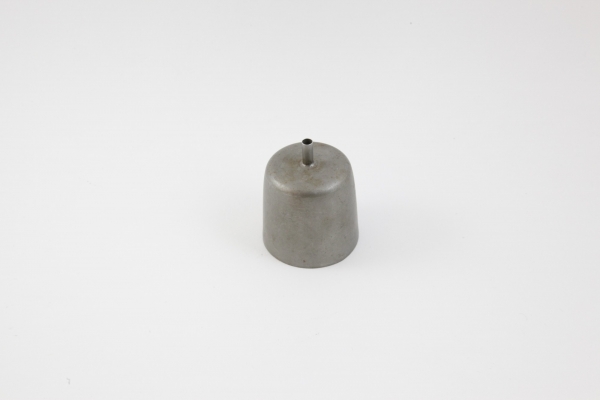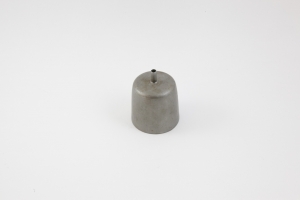
Create a selection
This unassuming metal cup is made from tin, a jovial element with ancient roots, a medieval mainstay and surprisingly high-tech usage today. Pure tin is silvery-white, as can be seen along the narrow top edge of this cup, but the remaining surface is a dull, grey colour that appears tarnished. This suggests a coating of a different alloy – perhaps pewter, an alloy of around 90% tin, the remainder copper, antimony and lead. Although alloying brings strength and hardness to an otherwise soft and malleable metal, these elemental additions may have resulted in the surface tarnish of this cup.
Tin is a sickly metal. The atoms inside tin arrange themselves in a crystalline structure; a neat, orderly arrangement of efficiently packed atoms in a pattern which repeats in 3D throughout the material. Some metals can pack their atoms in different formations at different temperatures, and these are called phases. When tin is cooled below 13.2°C, the atoms inside rearrange themselves into a different phase. This low-temperature phase is much more brittle than tin at room temperature, and causes a swelling of the material by over 25%. The result is a spontaneous crumbling and disintegration of tin objects, a phenomenon nicknamed ‘tin pest’ or ‘tin disease’. Napoleon is famously reputed to have suffered from tin pest when the buttons on his uniform turned to dust in the bitter Russian winter. Speaking of pests, tin can also grow whiskers. These are thin hairs of metal which protrude over time from the surface of electronic components made from tin, and can cause catastrophic short-circuiting unless carefully managed.
Tin is an ancient metal, whose extraction from ores (together with copper) heralded the beginning of the Bronze Age around 3000 BC. Bronze was a significant step in the history of metalworking – the intentional alloying of metals together produced a material which was stronger, harder and easier to work with to make tools, weaponry and household objects. During the European Middle Ages, pewter – an alloy made from predominantly tin – was used extensively for plates, cups and bowls, until it became overtaken by porcelain in the 18th Century. Today, tin is a vital component of another material – indium tin oxide – a transparent substance which conducts electricity, and from which touchscreens (a very different form of cutting-edge technology) are made. Tin is also used as solder to join pipes and electrical circuits, and as a passive plating for steel in ‘tin can’ food containers. A vital industrial use for tin is in the float glass process, where molten glass is floated on a bath of molten tin to produce large, flat and flawless panes of glass.
Sample ID: 144
Add materials you find interesting to your own selections.
Use the  button to select a material and get started.
button to select a material and get started.

